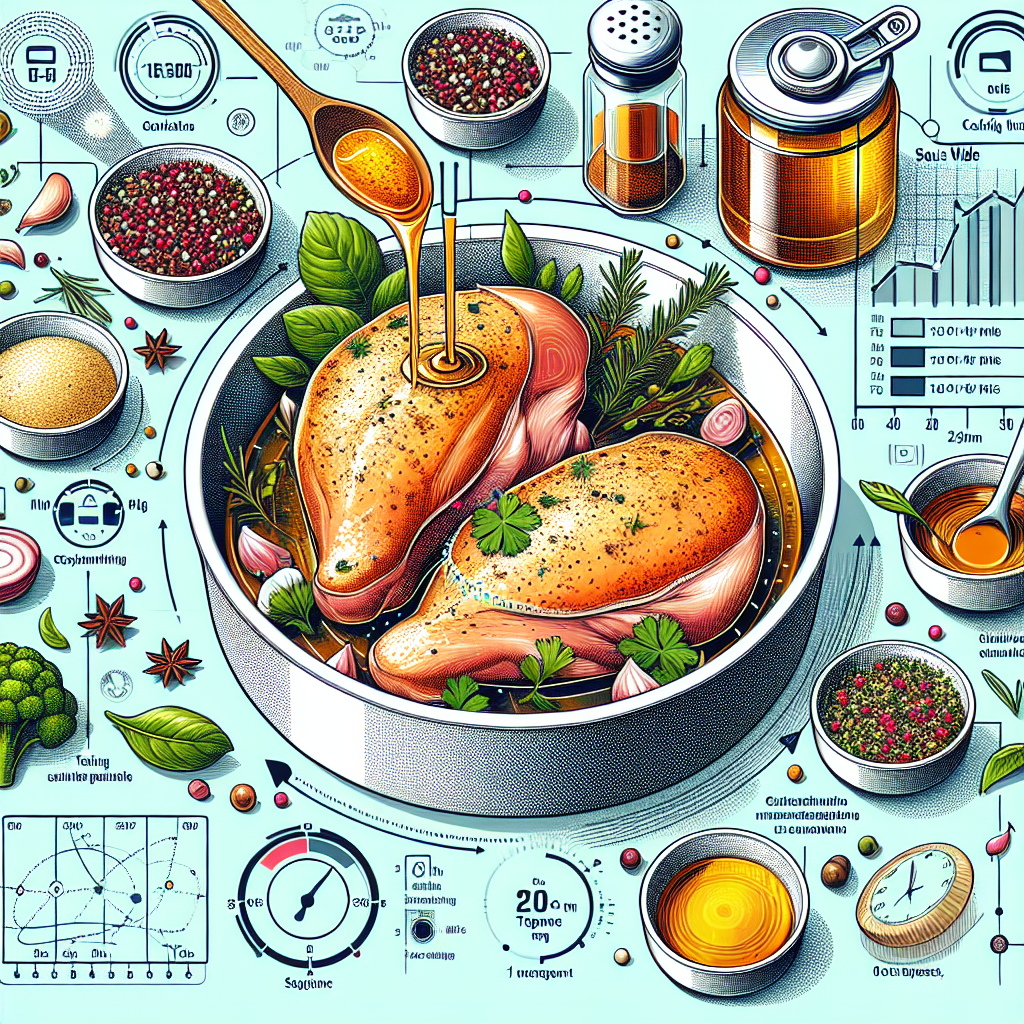
If you’ve ever wondered how to achieve perfectly cooked chicken breasts every time you use your sous vide machine, then look no further! In this article, we will explore the best sous vide cooking times for chicken breasts, ensuring that you achieve the juiciest, most tender results with minimal effort. Whether you prefer a juicy medium-rare or a well-done chicken breast, we’ve got you covered. So, let’s dive in and discover the secrets to achieving restaurant-quality chicken breasts in the comfort of your own kitchen. If you’re looking for a foolproof way to cook chicken breasts to perfection every time, look no further than sous vide cooking. Sous vide, which means “under vacuum” in French, is a cooking technique that involves vacuum-sealing food in a plastic bag and cooking it in a precisely controlled water bath. This method has gained popularity in recent years for its ability to deliver consistently juicy, flavorful, and tender results. In this article, we will explore the many benefits of using sous vide for chicken breasts, discuss the factors that affect cooking times, provide recommended temperatures for different levels of doneness, offer tips for achieving the best results, and share some delicious recipes to inspire your culinary adventures.
Sous Vide Cooking Benefits
One of the key benefits of sous vide cooking is its ability to deliver consistent results. Unlike traditional cooking methods where the temperature can fluctuate, sous vide cooking allows you to set the exact temperature you want your chicken breasts to reach. This precision ensures that your chicken is cooked to perfection every time, eliminating the risk of undercooked or overcooked meat.
Another advantage of sous vide cooking is that it enhances the flavor and texture of chicken breasts. By cooking the chicken in its own juices and seasonings, the flavors become more concentrated, resulting in a more intense and delicious taste. Additionally, the gentle and even heat of the water bath helps retain moisture, resulting in tender and juicy chicken breasts.
In addition to flavor and texture, sous vide cooking also helps preserve the nutrients in chicken breasts. The low and controlled temperatures used in sous vide cooking help minimize nutrient loss that can occur with higher heat cooking methods like grilling or frying. This means that you can enjoy all the nutritional benefits of chicken without compromising on taste or texture.
Factors Affecting Sous Vide Cooking Times
Several factors can influence the cooking times when using the sous vide method for chicken breasts. It’s important to take these factors into account to ensure that your chicken is cooked to your desired level of doneness.
The thickness of your chicken breasts is a crucial factor in determining the cooking time. Thicker chicken breasts will naturally require more time to cook compared to thinner ones. It’s important to consider the size of your chicken breasts and adjust the cooking time accordingly to achieve the desired results.
The initial temperature of the chicken breasts can also affect the cooking time. If your chicken breasts are chilled, they will take longer to cook compared to room temperature or slightly warmed chicken breasts. It’s recommended to bring your chicken breasts to room temperature before cooking to ensure even and consistent results.
Another factor that plays a role in sous vide cooking times is the desired level of doneness. Everyone has their own preference when it comes to how well-done they like their chicken, and sous vide cooking allows you to achieve your desired level of doneness with precision. Whether you prefer medium-rare, medium, medium-well, or well-done chicken breasts, there is a recommended sous vide temperature that will help you achieve your desired results.
Recommended Sous Vide Temperatures for Chicken Breasts
To help you achieve the perfect level of doneness, here are the recommended sous vide temperatures for chicken breasts:
- Medium-Rare: 140°F (60°C)
- Medium: 150°F (66°C)
- Medium-Well: 160°F (71°C)
- Well-Done: 165°F (74°C)
By setting your water bath to the corresponding temperature, you can cook your chicken breasts to your preferred level of doneness with accuracy.
Sous Vide Cooking Times for Chicken Breasts
Now that you know the recommended sous vide temperatures, let’s discuss the cooking times for different thicknesses of chicken breasts. It’s important to note that these times are approximate and may vary depending on factors such as the initial temperature of the chicken and personal preference. Always use a reliable sous vide machine and a food thermometer to ensure that your chicken is cooked to the appropriate internal temperature.
Thin Chicken Breasts (1/2 inch or 1.3 cm)
Cooking Time: 1 to 1.5 hours
Medium-Thick Chicken Breasts (3/4 inch or 1.9 cm)
Cooking Time: 1.5 to 2 hours
Thick Chicken Breasts (1 inch or 2.5 cm)
Cooking Time: 2 to 2.5 hours
Extra Thick Chicken Breasts (1 1/2 inches or 3.8 cm)
Cooking Time: 2.5 to 3.5 hours
It’s essential to adjust the cooking time based on the thickness of your chicken breasts to ensure that they are fully cooked and reach the desired level of doneness.

Tips for Sous Vide Cooking Chicken Breasts
To help you take your sous vide chicken breast game to the next level, here are some expert tips and techniques:
Brining for Flavor Infusion
Before cooking your chicken breasts sous vide, consider brining them to infuse them with additional flavor. Brining involves soaking the chicken in a mixture of water, salt, and other seasonings to enhance both the taste and texture. This step can be done prior to sealing the chicken in the vacuum bag and will result in even more flavorful and succulent chicken breasts.
Seasoning Before or After Sous Vide
You can choose to season your chicken breasts before or after sous vide cooking, depending on your personal preference. Seasoning before cooking allows the flavors to penetrate the meat during the sous vide process. However, seasoning after sous vide and before searing can result in a more vibrant and pronounced taste. Experiment with different seasoning methods to find the one that suits your taste buds best.
Searing for a Crispy Exterior
While sous vide cooking delivers perfectly cooked and tender chicken breasts, it lacks the crispy exterior that many people love. To achieve that desired crispiness, simply sear the chicken breasts in a hot pan or use a kitchen torch to add a beautiful golden crust. The searing process should be done right before serving to maintain the juices and tenderness of the chicken.
Marinating After Sous Vide
If you prefer marinated chicken breasts, you can also marinate them after sous vide cooking. Once cooked, remove the chicken breasts from the vacuum bag, pat them dry with a paper towel, and then let them marinate in your desired marinade for a few hours or overnight. This will infuse the chicken with additional flavors and result in a delightful marinated chicken dish.
Safety Guidelines for Sous Vide Cooking
While sous vide cooking is a safe and effective cooking method, it’s important to follow certain safety guidelines to ensure the quality and safety of your chicken breasts:
Proper Handling and Storage of Chicken
Always handle raw chicken with care to prevent cross-contamination. Thoroughly wash your hands, utensils, and work surfaces before and after handling raw chicken. It’s also important to store chicken properly in the refrigerator, separate from other foods, to prevent the growth of harmful bacteria.
Prolonged Cooking Times
Sous vide cooking involves cooking food at low temperatures for extended periods. While this method helps to achieve tender and juicy results, it’s essential to ensure that your chicken reaches the recommended internal temperature to kill any potential bacteria. Use a food thermometer to monitor the temperature and avoid undercooking.
Pasteurization Principles
To ensure food safety, it’s important to understand the principles of pasteurization. Cooking your chicken breasts at the recommended sous vide temperatures and times will effectively pasteurize the meat, eliminating harmful bacteria. However, it’s recommended to consume or properly store the cooked chicken within a safe time frame to prevent bacterial growth.
Best Sous Vide Chicken Breast Recipes
Now that you have a good understanding of sous vide cooking times and techniques for chicken breasts, let’s explore some delicious recipes to inspire your culinary adventures:
Sous Vide Lemon Herb Chicken Breast
This recipe features tender and flavorful chicken breasts infused with the bright and zesty flavors of lemon and herbs. Simply season the chicken, seal it in a vacuum bag with lemon slices and fresh herbs, and cook sous vide for the recommended time. Finish with a quick sear for a burst of additional flavor.
Sous Vide Garlic Parmesan Chicken Breast
Indulge in the rich and savory flavors of garlic and parmesan with this mouthwatering recipe. After cooking the chicken breasts sous vide, coat them with a mixture of minced garlic, grated parmesan, and breadcrumbs. Give them a quick broil in the oven to achieve a golden and crispy crust.
Sous Vide BBQ Chicken Breast
If you’re a fan of barbecue flavors, you’ll love this sous vide BBQ chicken breast recipe. Rub the chicken breasts with your favorite BBQ seasoning and seal them in a vacuum bag with a generous amount of BBQ sauce. Cook sous vide until tender, then finish on the grill or under the broiler for that classic smoky and caramelized BBQ taste.
Sous Vide Teriyaki Chicken Breast
Transport your taste buds to the flavors of Japan with this delicious teriyaki chicken breast recipe. Marinate the chicken in a homemade or store-bought teriyaki sauce, then cook sous vide for the recommended time. Finish with a quick sear and serve with steamed rice and vegetables for a complete and satisfying meal.
FAQs about Sous Vide Cooking Times for Chicken Breasts
To address some common questions and concerns, here are answers to frequently asked questions about sous vide cooking times for chicken breasts:
Can I use frozen chicken breasts?
While it’s generally recommended to use thawed chicken breasts for sous vide cooking, you can sous vide frozen chicken breasts as well. However, it will take longer for the chicken to cook through. It’s essential to adjust the cooking time accordingly and ensure that the chicken reaches the recommended internal temperature.
Can I sous vide bone-in chicken breasts?
Yes, you can absolutely sous vide bone-in chicken breasts. Just keep in mind that bone-in chicken may take slightly longer to cook compared to boneless chicken breasts. Adjust the cooking time accordingly based on the thickness of the chicken and the desired level of doneness.
Can I cook chicken breasts with the skin on?
Yes, you can cook chicken breasts with the skin on using the sous vide method. However, the skin will not become crispy during the cooking process. If you prefer crispy skin, it’s best to remove the skin before cooking and sear it separately.
Can I sous vide chicken breasts in a marinade?
While you can marinate chicken breasts before or after sous vide cooking, it’s not recommended to sous vide chicken directly in a marinade. The excess liquid from the marinade can affect the cooking process and result in uneven results. It’s best to remove the chicken from the marinade before sealing it in a vacuum bag for sous vide cooking.
Conclusion
Sous vide cooking is a game-changer when it comes to cooking chicken breasts. With its ability to deliver consistent results, enhanced flavor and texture, and preservation of nutrients, it’s no wonder why so many home cooks and professionals alike are embracing this cooking method. By considering factors such as thickness, initial temperature, and desired level of doneness, you can achieve perfectly cooked chicken breasts every time. With the variety of delicious recipes and helpful tips, you’re now ready to embark on your sous vide chicken breast journey. So go ahead, grab your sous vide machine, and get ready to impress your taste buds with the juiciest, most flavorful chicken breasts you’ve ever had. Have fun experimenting, and enjoy the delicious results!






